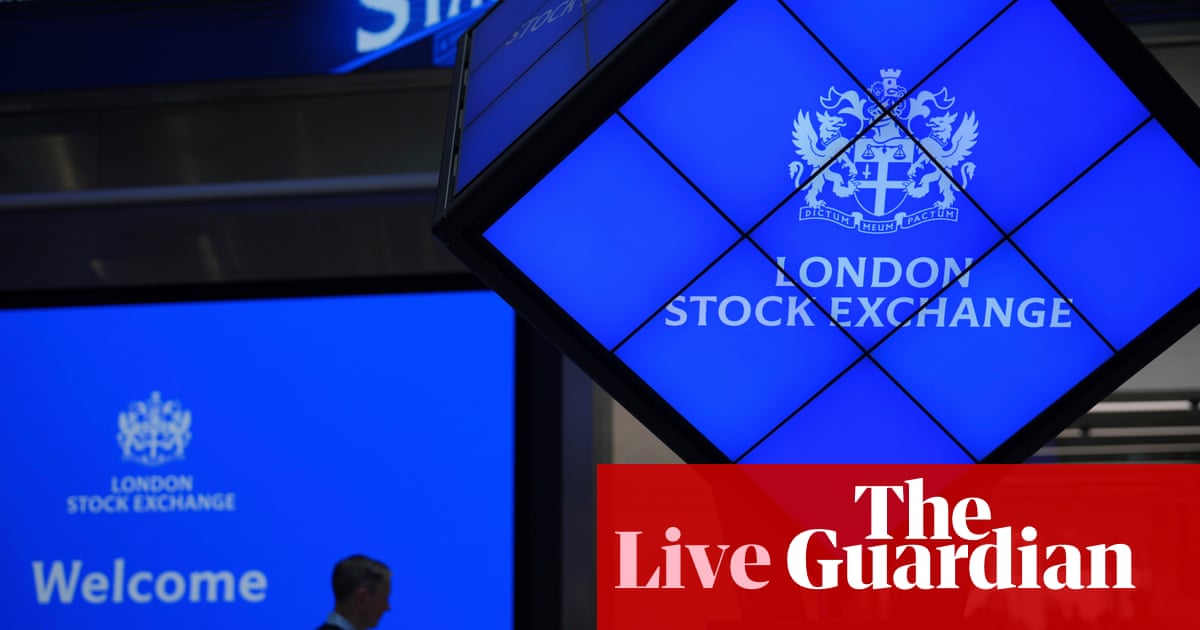Goldman Sachs: 45% risk of US recession in next year
Goldman Sachs has slashed its forecast for US economic growth this year, and warned there is a growing risk that America falls into recession in the next year.
Goldman has lowered its 2025 growth forecast from 1.0% to 0.5%, due to fears that Donald Trump will raise tariffs by much more than it had expected.
In a note titled “US Daily: Countdown to Recession”, Goldman also lifted its 12-month recession probability from 35% to 45%, following “a sharp tightening in financial conditions, foreign consumer boycotts, and a continued spike in policy uncertainty” following Trump’s tariff announcements.
Goldman analysts explain that they had expected the White House to announce a more aggressive tariff at first and then scale it back; instead, the new tariffs scheduled for 9 April would lift the effective tariff rate by more than expected.
They say:
First, financial conditions tightened more aggressively than we had expected in response to the White House’s announcement of its “reciprocal” tariff and the Chinese government’s announcement of its retaliatory tariffs on US exports.
This is partly because both announcements were more aggressive than expected. But it also suggests that the sensitivity of financial conditions to incremental tariffs is rebounding from the moderate levels of early 2025 toward the more outsized levels observed in the 2018-2019 trade war.

Second, our analysis of reduced foreign tourism to the US and foreign consumer boycotts suggests an additional 0.1-0.2pp hit to GDP growth in 2025. Our forecast had already assumed forceful retaliation by foreign governments, but we had not accounted for the effects of a consumer-led response.
Third, measures of policy uncertainty have spiked to levels far above those reached during the last trade war. The effects of policy uncertainty are likely to be much larger than in the first trade war because far more US companies are likely to be affected by uncertainty about the much larger and broader US and foreign tariffs this time, and some could also be affected by uncertainty about other policy areas, such as fiscal and immigration policy.

Key events
European markets off the lows
After a very choppy morning, European stocks are still deep in the red – but they have also recovered some of their earlier losses.
In London, the FTSE 100 share index is now down 3.5%, or 284 points lower, at 7772 points. That would be its lowest closing level in a year, just five weeks after it hit a record high over 8,900 points!
But this is also a recovery from the plunge this morning, that saw the FTSE 100 slump by 6%.
Indeed, we now have a few risers on the FTSE 100 today – including housebuilder Taylor Wimpey, Lloyds Banking Group and gambling firm Entain.
Across Europe, the picture is less grim too. Germany’s DAX, for example, is currently down 4% – having shed 10% of its value at one stage this morning.
Investors may be cheered by the news that Wall Street is not expected to plunge quite as much as initially feared – S&P 500 futures are currently down 1.7%….

Richard Partington
Reason to be cheerful: Morgan Stanley points out that, although the equity market is plunging, the credit market reaction has been fairly tempered, my colleague Richard Partington writes.
The usual correlation between equity market losses and bond market gains has returned – government bonds are rallying on the rush to safe havens, and amid expectations of a recession.
Morgan Stanley says corporate balance sheets have entered the latest period of turbulence in pretty good shape. That should be reassuring that the market meltdown ought not worsen further (that’s Richard’s interpretation…)
Morgan Stanley’s note says:
In the context of credit as the canary in the coal mine, we would highlight that in the recent instances where credit has played that role (the slowdowns in 2015/2018/2020, for example), there were signs of credit market excess (rising leverage, deteriorating balance sheet metrics).
In stark contrast, we are entering this period of turbulence with healthy corporate balance sheets, muted M&A/LBO activity, and little credit market excess. In addition, the last few years have seen significant inflows to credit from yield-based buyers – US life insurance companies with sticky liabilities that are unlikely to see redemptions based on market moves.
Largely for these reasons, new issue markets remain open, even for sub-IG [investment grade] borrowers. We would watch access to new issue markets, particularly for high-quality borrowers, as a barometer of credit markets freezing up.
The Bank of England’s most recent financial stability report also contains some reasons to be cheerful – globally, it found corporate and household balance sheets had remained resilient in aggregate, despite the recent dramatic increase in debt servicing costs.

Larry Elliott
Although the losses of recent days have been very painful for investors large and small, the market meltdown still has a way to go to match the crash of October 1987.
Our former economics editor Larry Elliott (a veteran of a fair few market crashes) reminds me.
Then, on the Monday and Tuesday the FTSE 100 fell by 23% in two days.
The Dow dropped by 22% on the Monday. In the days before modern communication Alan Greenspan, the newly appointed Fed chair, was on a plane from Washington while the carnage was happening. When he reached his destination (Dallas from memory) he asked how the Dow had finished. Down 508 he was told.
Mistakenly, Greenspan thought that meant down 5.08 points and assumed the Dow had had a late bounce as it sometimes does after a turbulent day. His relief was short lived!
Bloomberg: Three-day sell-off wipes out $9.5tn
We’re well into the third day of the market meltdown after Donald Trump’s ‘Liberation Day’ tariff announcement last Wednesday.
Bloomberg have calculated that around $9.5trn has been wiped off global share prices since the US president announced new trade levies on on friends, foes, and the penguins living on barren, uninhabited volcanic islands near Antarctica.
The carnage in financial markets worsened on Monday with stressed-out investors abandoning hopes that President Donald Trump would change his tariff policy.
Stocks tumbled, taking the three-day wipeout in global equity value to about $9.5 trillion. S&P 500 equity futures signaled a 3% loss and the VIX Index spiked above 50. Europe’s Stoxx 600 tumbled 5%. Asia capped the worst day since 2008. Treasuries and the yen gained as investors sought refuge.
JPMorga’s Dimon warns tariffs will lift prices and could cause recession
Jamie Dimon, the CEO of JP Morgan, has warned that Donald Trump’s new tariffs will hurt growth and drive up prices for consumers.
In his annual letter to shareholders, Dimon – one of the most influential voices on Wall Street – says:
The recent tariffs will likely increase inflation and are causing many to consider a greater probability of a recession. And even with the recent decline in market values, prices remain relatively high. These significant and somewhat unprecedented forces cause us to remain very cautious.
[Dimon is clearly correct – with Goldman Sachs lifting their US recession chances today]
In his letter, Dimon also warns that the US economy had already begun weakening before the recent tariff announcement.
In the short term, he says, tariffs will have “inflationary outcomes”, not only on imported goods but on domestic prices, as input costs rise and demand increases on domestic products.
[Reminder: tariffs are paid by the importer of foreign goods, not the overseas producer].
Dimon says:
How this plays out on different products will partially depend on their substitutability and price elasticity. Whether or not the menu of tariffs causes a recession remains in question, but it will slow down growth.
Elon Musk appears to be signalling his displeasure with Donald Trump’s trade war.
Over the weekend, the Tesla boss turned government official said he backed eventually ending all tariffs and creating a free-trade zone between the U.S. and the European Union.
And this morning, Musk has doubled down by posting a video of economist Milton Friedman using the example of the humble pencil as an example of how the free market creates the global cooperation needed produce goods cheaply and efficiently.
Trump’s “medicine” has left equities with a bitter taste, reports Thomas Mathews, Head of Markets for Asia Pacific at Capital Economics, who says:
The carnage in global equity markets has continued after President Trump doubled down on his tariff plans, noting that “sometimes you have to take a medicine to fix something”.
We still think he will lower the dosage by paring back his tariffs. But, if he doesn’t, equities could get a lot sicker yet.
Wall Street could tumble into a bear market today, judging by the futures markets.
The S&P 500 index is currently on track to fall around 3.5% when trading resumes, according to the futures market, with investors expected to hammer the sell button again.
Samer Hasn, senior market analyst at XS.com, said this morning:
S&P 500 futures continued to collapse in early trading this morning, along with global indices, falling nearly 5%. Nasdaq 100 futures also fell nearly 6% at the same time.
S&P 500 futures officially entered bear territory today, having fallen more than 22% from their all-time highs. US markets are set to dive this week in the bear market, amid gloomy prospects surrounding the US trade war and weak signals regarding the possibility of a settlement to the conflict.
Tariffs are not new, and markets reacted strongly to them last week. However, Trump’s indications over the weekend that he will maintain the tariffs further frustrate markets, which are clinging to hope for a de-escalation. Trump’s weekend golfing after the widespread market collapses could also be interpreted as a sign of indifference – which he has denied – to the consequences of his recent actions, suggesting he may be sticking to his plan.
Furthermore, although many leaders of countries affected by the tariffs are inclined to negotiate and make steps that would reduce the tariffs imposed on them, recent signs and reports do not suggest any progress toward a diplomatic solution to the trade war. For example, China and the United States have been unable to move forward on the tariff negotiations, and these efforts have failed, ending up in the imposition of massive tariffs on China, which has responded with massive counter-tariffs. This escalation and counter-escalation keeps hope for negotiations slim, according to the Wall Street Journal.
We’ve reached the scale in the crisis when central banks are pondering whether to intervene in the markets.
Over in Jakarta, Indonesia’s central bank said today it would “intervene aggressively” in domestic foreign exchange markets when they re-open on Tuesday for the first time since new U.S. tariffs were announced, Bloomberg reports.
Bank Indonesia said in a statement that it had already intervened offshore in Asia, European and New York curency markets.
It added:
“Bank Indonesia’s series of measures are aimed at stabilising the rupiah exchange rate and maintaining the confidence of market participants and investors in Indonesia.”
In Taipei, Taiwan’s central bank said it will intervene if necessary to ensure the stability of the Taiwan dollar exchange rate, ading that it has “sufficient ability” to deal with fluctuations.
We are now back on ‘US recession watch’ thanks to Trump’s tariffs, reports. Dario Perkins, City economist at TS Lombard.
Perkins (inventor of the “moron risk premium” concept during the UK bond market crash under Liz Truss), told clients:
With Liberation Day causing shockwaves across global markets (our expectations were low but holy…) we are now firmly back on US recession watch. Prices will rise, real incomes will drop, and it will be the labour market that determines what happens after that.
As always, employment is the key to US recessions.
“But it’s just Wall Street, not Main Street?” 1. Tariffs are highly regressive, hitting people on low incomes hardest. 2. Corporate profits will decline and companies will respond by firing workers. That ain’t good for “worker power” ..
— Dario Perkins (@darioperkins) April 7, 2025
To no-one’s surprise, economic confidence across the eurozone has slumped this month.
The Sentix Investor Confidence Index has tumbled to -19.5 points, its lowest level since October 2023, down from -2.9 in March.
Sentix, the research group, explains that “Trump’s tariff hammer” has hammered optimism, with economic expectations for the eurozone now falling at a record pace.
The report adds:
US economic expectations fell to their lowest level since October 2008, while the tariff shock fuelled fears of a global recession.
The Euro Zone Sentix Index plummeted to -19.5 in April, a significant drop from -2.9 in March, far worse than the Reuters poll estimate of -10.0. #EuroZone 📉
— MiloX Trading (@CryptoMilox) April 7, 2025
Gas prices are weakening today too, a sign that the markets are pricing in weaker economic growth and less demand for energy.
The month-ahead price of UK gas has fallen by 3.6%, to 85.5p per therm, the lowest since last September.
European gas prices fell more sharply; their benchmark futures fell as much as 8% on Monday after wiping out more more than 10% last week, Bloomberg reports, adding:
Fears that US President Donald Trump’s trade restrictions will slow down the economy have caused commodity prices to plummet, with traders expecting it could spell less demand for energy shipments.
A Chinese foreign ministry spokesperson has warned that threats and pressure are not the right way to deal with China, after describing Donald Trump’s “reciprocal tariffs” as bullying.
Spokesperson Lin Jian told a press conference today that the tariffs are “typical unilateralism and protectionism, and economic bullying”, Reuters reports, adding:
“The abuse of tariffs by the United States is tantamount to depriving countries, especially those in the Global South, of their right to development.”
Goldman Sachs: 45% risk of US recession in next year
Goldman Sachs has slashed its forecast for US economic growth this year, and warned there is a growing risk that America falls into recession in the next year.
Goldman has lowered its 2025 growth forecast from 1.0% to 0.5%, due to fears that Donald Trump will raise tariffs by much more than it had expected.
In a note titled “US Daily: Countdown to Recession”, Goldman also lifted its 12-month recession probability from 35% to 45%, following “a sharp tightening in financial conditions, foreign consumer boycotts, and a continued spike in policy uncertainty” following Trump’s tariff announcements.
Goldman analysts explain that they had expected the White House to announce a more aggressive tariff at first and then scale it back; instead, the new tariffs scheduled for 9 April would lift the effective tariff rate by more than expected.
They say:
First, financial conditions tightened more aggressively than we had expected in response to the White House’s announcement of its “reciprocal” tariff and the Chinese government’s announcement of its retaliatory tariffs on US exports.
This is partly because both announcements were more aggressive than expected. But it also suggests that the sensitivity of financial conditions to incremental tariffs is rebounding from the moderate levels of early 2025 toward the more outsized levels observed in the 2018-2019 trade war.
Second, our analysis of reduced foreign tourism to the US and foreign consumer boycotts suggests an additional 0.1-0.2pp hit to GDP growth in 2025. Our forecast had already assumed forceful retaliation by foreign governments, but we had not accounted for the effects of a consumer-led response.
Third, measures of policy uncertainty have spiked to levels far above those reached during the last trade war. The effects of policy uncertainty are likely to be much larger than in the first trade war because far more US companies are likely to be affected by uncertainty about the much larger and broader US and foreign tariffs this time, and some could also be affected by uncertainty about other policy areas, such as fiscal and immigration policy.
Vix volatility index rising
Wall Street’s ‘fear index’ is surging higher again today.
The VIX index, which measures market volatility and uncertainty, has almost doubled today to around 60 points.
It’s at its highest level since last August, when US recession fears hit markets.
[I initially thought it was the highest since March 2020, but it seems we’re not there yet….]










